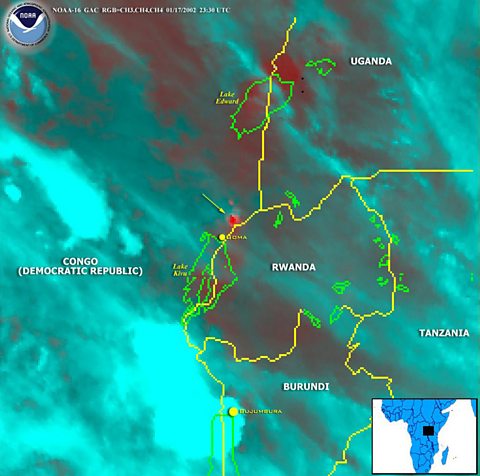Case study - volcanic eruption in a developing country: Mt Nyiragongo
Nyiragongo is a steep-sided, active volcano. It is located in the Democratic Republic of Congo, 10km (6 miles) from the city of Goma. The volcano is part of the East African Rift Valley. This is an area of many faultA fracture in the Earth's crust. where the plates are being stretched as they move away from each other.
The eruption happened on 22 May 2021. Before this, there had been another large eruption in 2002, which had killed 250 people. The volcano has a lava lake in its crater. In both eruptions, fissures opened in the south side of the volcano and streams of lava from the lake drained through. The lava reached speeds of 64 km/h (40 mph.) The 2021 eruption followed a similar path to the 2002 eruption, moving towards Goma and the border with Rwanda.

Primary impacts
- At least 32 people died
- An estimated 450,000 were displaced or evacuated
- 17 nearby villages were badly affecting by the fast flowing lava. Hundreds of homes, a school and three health-care centres were destroyed.
Secondary impacts
- Several earthquakes took place in the days after the eruption. The earthquakes destroyed buildings, and damaged underground water pipes and a reservoir
- The volcanoâs magma is rich in carbon dioxide, which is invisible and difficult to detect. This gas is denser than air, so it gathers in low-lying areas. Carbon dioxide in such quantities can be toxic for humans to breathe
- Between 3,000 to 8,000 people crossed the border to find safety in Rwanda
- Around ten people died in a road traffic accident caused by the evacuation. Four prisoners died as they tried to escape their cells.
Responses
- The authorities built temporary shelters in six camps to house any displaced people. However, heavy rainfall in the region meant that many of the shelters were destroyed
- UNHCR (the United Nations High Commissioner for Refugees) supported more than 1,300 families by funding accommodation in Goma
- Charities helped with the emergency response and also collected money to rebuild homes and provide support to people.